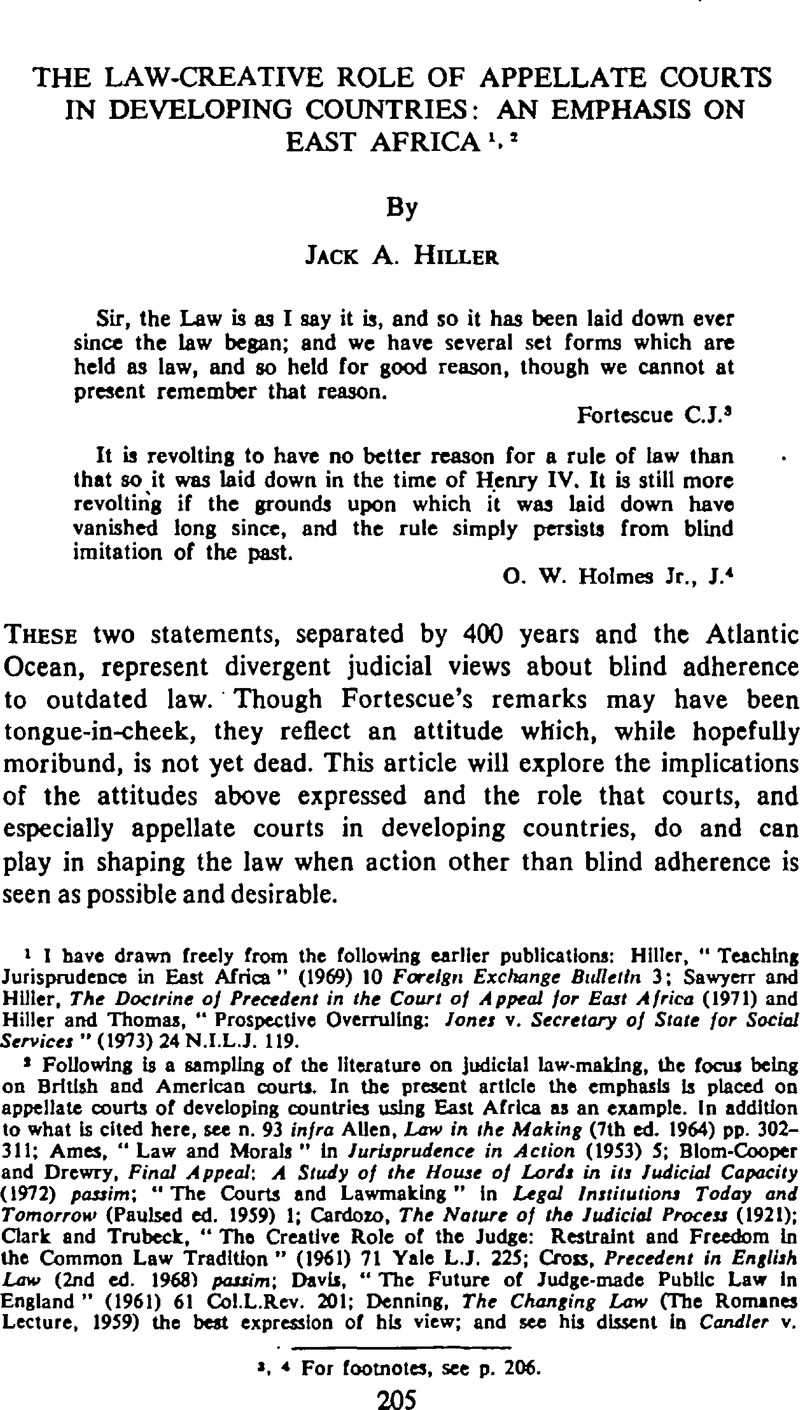No CrossRef data available.
Article contents
The Law-Creative Role of Appellate Courts in Developing Countries: An Emphasis on East Africa1, 2
Published online by Cambridge University Press: 17 January 2008
Abstract

- Type
- Articles
- Information
- Copyright
- Copyright © British Institute of International and Comparative Law 1975
References
1 I have drawn freely from the following earlier publications: Hiller, “Teaching Jurisprudence in East Africa” (1969) 10 Foreign Exchange Bulletin 3; Sawyerr and Hiller, The Doctrine of Precedent in the Court of Appeal for East Africa (1971) and Hiller and Thomas, “Prospective Overruling: Jones v. Secretary of State for Social Services” (1973) 24 N.I.L.J. 119.
2 Following is a sampling of the literature on Judicial law-making, the focus being on British and American courts. In the present article the emphasis Is placed on appellate courts of developing countries using East Africa as an example. In addition to what is cited here, see n. 93 infra Allen, Law in the Making (7th ed. 1964) pp. 302−311; Ames, “Law and Morals” In Jurisprudence in Action (1953) 5; Blom-Cooper and Drewry, Final Appeal: A Study of the House of Lords in its Judicial Capacity (1972) passim; “The Courts and Lawmaking” in Legal Institutions Today and Tomorrow (Paulsed ed. 1959) 1; Cardozo, The Nature of the Judicial Process (1921); Clark and Trubeck, “The Creative Role of the Judge: Restraint and Freedom in the Common Law Tradition” (1961) 71 Yale L.J. 225; Cross, Precedent in English Law (2nd ed. 1968) passim; Davis, “The Future of Judge-made Public Law In England” (1961) 61 Col.L.Rev. 201; Denning, The Changing Law (The Romanes Lecture, 1959) the best expression of his view; and see his dissent in Candler v. Crane, Christmas & Co. [1951] 2 K.B. 164; Devlin, Samples of Lawmaking (1962) passim; Diplock, The Courts as Legislators (Holdsworth Club Lecture, 1965); Douglas, “Stare Dccisls” 4 The Record of the Assn. of the Bar of the City of New York No. 5, at p. 152 (1949), reprinted In (1949) 49 Col.L.Rev. 735 and In part in Essays on Jurisprudence from the Columbia Law Review (1963) 18 (hereafter cited as Columbia Essays); Evershed, “The Judicial Process in Twentieth Century England” (1961) 61 Col.L.Rev. 761, reprinted in Columbia Essays 69; Frank, “Words and Music: Some Remarks on Statutory Interpretation” (1947) 47 Col.L.Rev. 1259; Friedmann, “Legal Philosophy and Judicial Law-making” (1961) 61 Col.L.Rev. 861, reprinted In Columbia Essays 101; Friedmann, Legal Theory (5th ed. 1967) Chap. 32; Georges, Law and its Administration in a One Party State (Jamet and Kassam eds. 1973) passim; Ghal and McCauslan, Public Law and Political Change in Kenya 369, 378 (1970); Hiller and Thomas, supra n. 1; Jaffe, English and American Judges as Lawmakers (1969); Llewellyn, The Common Law Tradition: Deciding Appeals (1960) passim; Lloyd, Introduction to Jurisprudence (3rd ed. 1972), pp. 721−729, 746−754, 783−786; Palley, “Rethinking the Judicial Role” (1969) 1 Zambia L.J. 1; Reid, “The Judge as Law-Maker” (1972) J.S.P.T.L. 22; Radin, “Case Law and Stare Decisis: Concerning Prafudiiienrecht in Amerika” (1933) 33 Col.L.Rev. 199, reprinted In Columbia Essays 3; Sawyerr and Hiller, supra n. 1; Seidman, “The Judicial Process Reconsidered in the Light of Role-Theory” (1969) 32 M.L.R. 516; Stevens, “Hedley Byrne v. Heller: Judicial Creativity and Doctrinal Possibility” (1964) 27 M.L.R. 121; Stevens, “The Role of a Final Appeal Court In a Democracy: The House of Lords Today” (1965) 28 M.L.R. 509 (one of the best discussion of the topic); Veltch, “Some Examples of Judicial Law Making in African Legal Systems” (1971) 34 M.L.R. 42.




